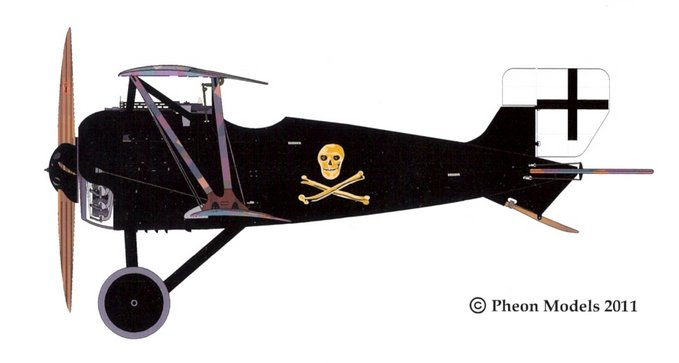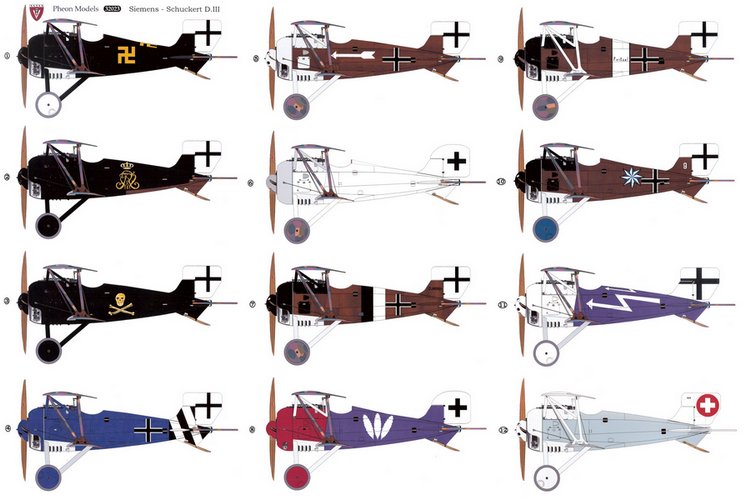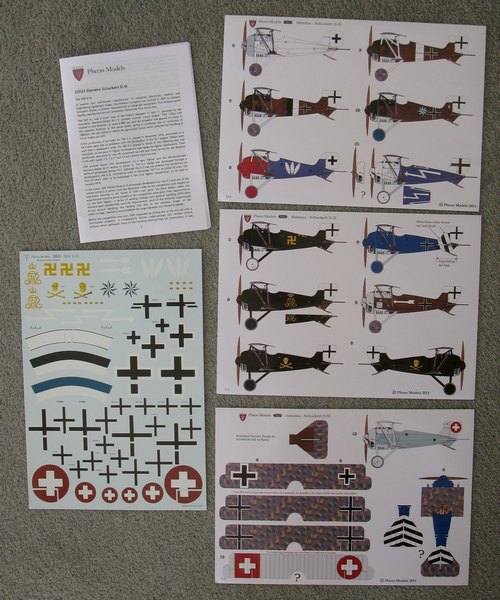Pheon Decals | 1/32 decals for Roden's Siemens Schuckert D.III
Reviewed by James Fahey

The Roden 1/32 Siemens Schuckert DIII was warmly welcomed by the WWI modelling fraternity when it came out in late 2009. It is a pugnacious looking fighter that saw only limited service in the last year of WWI due to problems with engine cooling. By the time the recalled aircraft had been refitted with improved engines, a new rudder, balanced ailerons and a cut‑away cowling for better cooling, the war was nearly over. It is generally regarded as one of the best German fighters of WWI and its phenomenal climb rate meant many DIIIs were used by Home Defense (Kest) units as well as some front line Jastas.
The kit comes with three markings options which left plenty of room for some enterprising after-market decal producer to provide modellers with a wider range of options. Pheon Models have certainly done that with this release which covers 12 aircraft (virtually all the aircraft featured in the Datafile from Albatros Productions).

Markings Options
The first three options are from Kest 5 which had black fuselages and personal markings in a pale colour which is not confirmed but portrayed by Pheon in golden yellow.
- 8356/17 flown by Vzfw. Fritz Beckhardt of Kest 5
- 1618/18 flown by Oberleutant Heinrich Dembrowski of Kest 5. The crest is from 2. Ostpreußische Grenadier-Regiment Friedrich Wilhelm I. Nummer 3
- 8344/17 Offizieraspirant Arnold Eger of Kest 5. Pheon have correctly shown the different skull and crossbone designs for each side of the aeroplane.
These three pilots and their aeroplanes came to public attention two days after the Armistice when they flew to Switzerland and were interned (see this thread from The Aerodrome http://www.theaerodr...witzerland.html). - 1626/18 Vzfw Reimann of Kest 4b. Pheon’s portrayal of this aeroplane is a revision from earlier depictions which had the dark red-brown stained fuselage. Their study of the photographic evidence concludes 1626 had a painted fuselage and spinner. The colour is unknown but is portrayed as blue in the colour profile. Unfortunately the black stripes are not included in the decal sheet so modellers will have to carefully mask these.
- 3025/18 Kest 8. This aircraft with its white arrow marking was only delivered two days before hostilities ended, and was much photographed in American hands after the Armistice
- 8346/17 of Jasta 19. This was an early version of the DIII and requires Loon Models conversion set LO32006 which has resin parts to replace the cowling, ailerons, elevator, rudder (marketed by Roll Models in the US).
- 1628/18 flown by Ltn Paul Leim of Kest 4b
- Flown by Ltn Ziegesar of Jasta 15. this aircraft is another early version of the DIII and requires the Loon Models conversion set
- ‘Fritzel’ flown by Carl Dunkel of Kest 4b
- 8349/18 of Kest 4b
- Flown by Ltn Alfred Greven of Jasta 12 with his striking lightning flash marking over the standard Jasta 12 blue fuselage and white nose.
- 606 ex 8356/17 (Option 1) repainted in Swiss service, Dubendorf 1920. This makes a interesting change from the German finishes.
There are enough national markings to build four models (three German and one Swiss). The decal sheet also includes Wotan propeller decals.
Instruction Booklet
The 14-page instruction booklet provides historical background including a brief description of the Kests of Kampfeinsitzer Staffeln, sections covering general colouring notes, national markings, references, decal application guide and notes on individual aeroplanes and pilots.
Three full pages are devoted to the Roden kit with tips for fixing some minor shortcomings and improving the accuracy of some details. Pheon note that the Roden kit is accurate in shape and outline, and the suggested modifications will not be particularly difficult to do.

Pheon decals are printed by Fantasy Printshop in the UK who have a solid reputation for quality. The review set had perfect registration and minimal carrier film.
Price: £15.00 plus P&P. Payment is by Paypal.
Availability: only direct from Pheon Models by email pheon.models@hotmail.co.uk.
Conclusion
Pheon have been relatively quiet for the last six months so it is pleasing to see this new release confirm their continued interest in WWI subjects.
This set offers excellent value for money with a generous choice of subjects. The full colour artwork/decal guides and the instruction booklet make for a top quality set. Lots of WWI modellers will have the Roden DIII in the stash - these decals will be the stimulus to get it onto the modelling bench.
The only difficulty with the set will be deciding which of the interesting and colourful markings to build!
Thanks to Pheon Models for providing the decals for this review.
© James Fahey 2012
This review was published on Monday, April 16 2012; Last modified on Wednesday, February 07 2018
